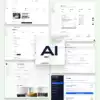How good is AI at design?
Published August 11, 2025
Share article on:

AI as designers
Ok, I’m not a big fan of AI. It’s amazing technology and certainly helps a ton in some fields. But, from my little bubble, I don’t really like the fact it’s getting better at replacing humans for the stuff they like doing and not helping with the hard and boring tasks as much.
Of course, because not everything is black or white, I use it sometimes to help me summarize long texts or with code I’m writing, for example. And there are some great helpers out there integrated in some tools I use regularly.
Regardless, it’s very much here, and everyone is talking about it. So I wanted to take look at what AI tools can do as designers. How can they be useful in our UI design process? How do they compete with us? How reusable are their outputs? Can they help us prototype faster?
Note: There are plenty of aspects & criticism about AI that I’m overlooking in this article;
My approach for this exploration:
For this little tour, I’m trying a few of them: Magic Patterns, Stitch Design, Lovable, Claude, Subframe & Figma Make in their free version.
- I focused on initial outputs from a single prompt to see what these tools deliver out of the box
- I'm looking primarily at the design process rather than diving deep into development workflows
- When I mention "design files," I'm distinguishing between visual design deliverables and code outputs - both are valid, but serve different purposes in a design workflow
Let's try it
I first want to see what their output looks like with one single prompt. I’m sure one can get much better results by continuing to prompt the AI, but I just want to see what comes up straight out of the box.
It’s also the opportunity for me to discover the different features they have to offer.
The prompt is
“Design an interface for constructors to get info about the work they have to do for a client. They also need to fill some details in, like upload pictures before and after, add comments and log dates. There's a side navigation with elements such as "home", "tasks", "Workers" etc.”
This prompt could probably be refined, I know there are people calling themselves prompts engineer nowadays, but I’m not one of them at this point.
First observations
- Generated interfaces are very generic. This was expected and I guess this can be a good thing depending on the situation.
- Some of them have some fairly limited customization options (mainly accent color and border radius or “themes”).
- The level of generated content and interactivity varies a lot. Some of them generated and linked (sub)pages I didn’t even describe while others have hover states on button at most.
- Responsiveness varies a lot too, from very bad to actually good.
But what surprised me the most, is that none of them gave me a design file as I would have expected. Only Magic Patterns & Stitch Design allowed some kind of design output (copy/paste into Figma).
You can read my first observations here.

Looking closer
Subframe seems to be the only one to have a manual edit mode: on top of being able to prompt, you can also move, edit and add components to the page. The editor relies on Tailwind classes for styles, and pre-made components. It also allows you to manually create other pages and link them to pre-existing ones.
Diving just a bit deeper, I can see that you can create your own components or import some. This, from a design point of view, is a big plus.

Magic Patterns seems to be able to recreate existing design and expand on them. It also offers collaborative features. You can prompt it to create components individually to add them to a library. These sound like great features in terms of reusability and building on top of current design, but I hit the free limit much quicker than with other tools, so I couldn’t test them.

In terms of first output, I’m most impressed with Figma make. It created pages I didn’t even ask for that made sense with the elements it created on the prompted screen. It does quite a lot on its own. Most notably, you can start from designs you’ve already created in Figma, which is much more interesting to me as a designer.

Claude generates some very generic interfaces. Something closer to wireframes almost. It feels like a good tool for quick prototyping.
Conclusion (for now)
I have mixed feelings (which might be the default in 2025).
The obvious goods and code as design
They are great for starting a project. To get a first draft out there or for some quick prototyping. Within seconds, we get an interface that mostly works (in terms of design good practices) and does the heavy lifting for us.
Also, they most certainly are an asset for developers. I have not talked about MCP or Cursor but I’m sure they can help bridge a gap between a design file and a finish product much easier and faster.
It’s almost back to the age old question of “should designers code?”. AI clearly does and, therefore, so are the people using it. And that’s maybe what surprised me the most here: the lack of design file output.
I’m 100% in favor of working prototype and looking at the design in the browser. But in terms of iterations, trial and error, putting things to the side and resurrecting them 2 months later, I still see the value in a design tool.
It’s so quick moving things around in a design tool, I don’t want to have to write text to do that. Also, when thinking about bigger projects and using a design system across several files with variants and all that jazz - it’s great to be able to have an overview of all the places that are impacted by a change.
The enjoyment in it
Coming back to my first point about AI getting better at replacing humans for the stuff they like doing: I like fiddling around. Be it in design tools or in code. I like alternating between chaos and structure when designing with my own little hands. I see craft and enjoyment as parts of the work. Should these factor in the decision of how we use AI? Of what clients are looking for? I don’t know. Also, for some people, the enjoyment is being able to create things they couldn’t before, quickly and easily. And that’s great for them, of course.
What I think I know is that regardless of the tools, a good knowledge of the internet, of the technology and of design remains important. The tools and hypes will keep changing, but being intentional about how we use them won't.
Published August 11, 2025
Share article on: